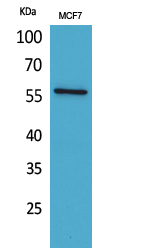ALK-1 Polyclonal Antibody
- 货号:YT5182
- 应用:WB;IHC;IF;ELISA
- 种属:Human;Mouse;Rat
- 简介:
- >>Cytokine-cytokine receptor interaction
- 蛋白名称:
- Serine/threonine-protein kinase receptor R3
- 免疫原:
- The antiserum was produced against synthesized peptide derived from the N-terminal region of human ACVRL1. AA range:21-70
- 特异性:
- ALK-1 Polyclonal Antibody detects endogenous levels of ALK-1 protein.
- 组成:
- Liquid in PBS containing 50% glycerol, 0.5% BSA and 0.02% sodium azide.
- 来源:
- Polyclonal, Rabbit,IgG
- 稀释:
- WB 1:500 - 1:2000. IHC: 1:100-300 ELISA: 1:20000.. IF 1:50-200
- 纯化工艺:
- The antibody was affinity-purified from rabbit antiserum by affinity-chromatography using epitope-specific immunogen.
- 储存:
- -15°C to -25°C/1 year(Do not lower than -25°C)
- 其他名称:
- ACVRL1;ACVRLK1;ALK1;Serine/threonine-protein kinase receptor R3;SKR3;Activin receptor-like kinase 1;ALK-1;TGF-B superfamily receptor type I;TSR-I
- 背景:
- This gene encodes a type I cell-surface receptor for the TGF-beta superfamily of ligands. It shares with other type I receptors a high degree of similarity in serine-threonine kinase subdomains, a glycine- and serine-rich region (called the GS domain) preceding the kinase domain, and a short C-terminal tail. The encoded protein, sometimes termed ALK1, shares similar domain structures with other closely related ALK or activin receptor-like kinase proteins that form a subfamily of receptor serine/threonine kinases. Mutations in this gene are associated with hemorrhagic telangiectasia type 2, also known as Rendu-Osler-Weber syndrome 2. [provided by RefSeq, Jul 2008],
- 功能:
- catalytic activity:ATP + [receptor-protein] = ADP + [receptor-protein] phosphate.,cofactor:Magnesium or manganese.,disease:Defects in ACVRL1 are the cause of hereditary hemorrhagic telangiectasia type 2 (HHT2) [MIM:600376]; also known as Osler-Rendu-Weber syndrome 2 (ORW2). HHT2 is an autosomal dominant multisystemic vascular dysplasia, characterized by recurrent epistaxis, muco-cutaneous telangiectases, gastro-intestinal hemorrhage, and pulmonary, cerebral and hepatic arteriovenous malformations; all secondary manifestations of the underlying vascular dysplasia.,function:On ligand binding, forms a receptor complex consisting of two type II and two type I transmembrane serine/threonine kinases. Type II receptors phosphorylate and activate type I receptors which autophosphorylate, then bind and activate SMAD transcriptional regulators. Receptor for TGF-beta. May bind activin as well.,simi
- 细胞定位:
- Cell membrane ; Single-pass type I membrane protein .

- Western Blot analysis of MCF7 cells using ALK-1 Polyclonal Antibody. Secondary antibody(catalog#:RS0002) was diluted at 1:20000

- Immunohistochemical analysis of paraffin-embedded mouse-brain, antibody was diluted at 1:100

- Western blot analysis of lysate from MCF7 cells, using ACVRL1 Antibody.






